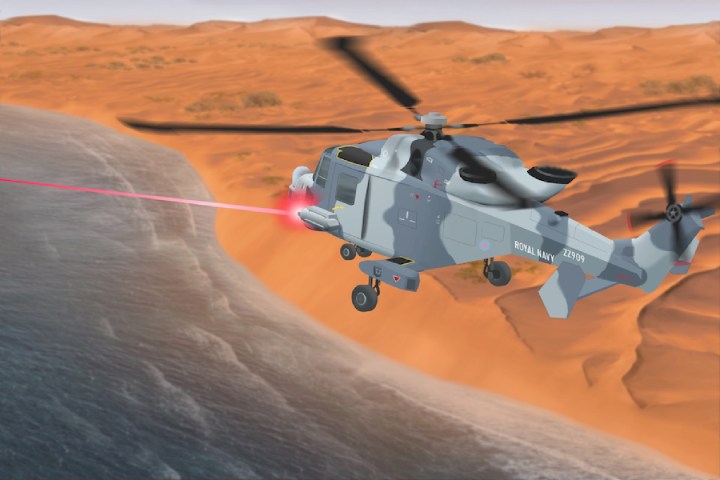
The U.K.’s Ministry of Defense is cranking up its focus on cutting-edge laser weapons, among other futuristic modes of attack, in an effort to revolutionize the battlefield for the 21st century. It has announced an investment of 130 million British pounds ($162 million) in order to test out a number of “directed energy weapons,” starting in 2023. These field tests will involve both Royal Navy ships and British Army vehicles.
Should all go according to plan, the MOD’s Novel Weapons Program could reach the combat frontline inside of a decade. This would not just be on board Royal Navy and British Army vehicles but across all branches of the military. The Ministry of Defense has not detailed exactly how these weapons may be deployed, although rendered images depict weapons mounted on ships and helicopters.
“Laser and radio frequency technologies have the potential to revolutionize the battlefield by offering powerful and cost-effective weapons systems to our Armed Forces,” Defence Secretary Penny Mordaunt said in a statement. “This significant investment demonstrates our commitment to ensuring our Armed Forces operate at the forefront of military technology.”
The MOD’s laser weapons systems deploy high-energy light beams, which could be used to target and destroy enemy drones and missiles. Radio frequency weapons, meanwhile, are designed to disrupt and disable computers and electronics used by enemy forces. The MOD hopes that the new electricity-powered weapons systems will solve a number of combat problems, such as the need to replenish ammunition in order for weapons to be effective.
This isn’t the first time that the U.K. military has shown an interest in futuristic weapons systems. It has already invested in a “world-first” laser weapon technology called Dragonfire. This system, which combines multiple laser beams to create one of the most powerful laser weapons systems yet developed, will be tested later this year. The MOD has also investigated radio frequency directed-energy weapons dating back 30 years.
Between this and the other futuristic weapons systems being developed by governments and private companies around the world, warfare is about to look a whole lot more science-fiction. And we’re not sure whether that’s a good or a bad thing!


